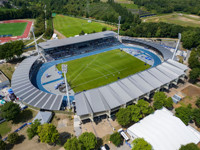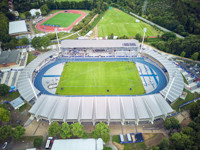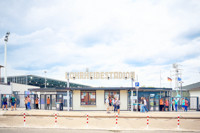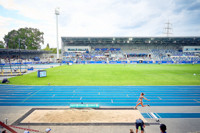Lohrheidestadion
| Capacity | 16 387 |
|---|---|
| 8,020 (Seats) | |
| Country | Germany |
| City | Bochum |
| Clubs | SG Wattenscheid 09, TV Wattenscheid 01 |
| Inauguration | 1954 |
| Renovations | 1972, 1975, 1991–1992, 2002, 2023–2025 |
| Address | Lohrheidestraße 82, 44866 Bochum-Wattenscheid |
Advertisement
Lohrheidestadion – stadium description
What is Lohrheidestadion like in a nutshell?
Lohrheidestadion was built in 1954 in Wattenscheid – now the western district of Bochum, but until the end of 1974 a separate municipality. Initially, the venue featured a simple design: around the running track stretched uniform, uncovered stands built on earth embankments.
Over time, two new freestanding stands were built along the pitch – the eastern one opened in 1992, and the western one followed in 2025 (at that time, the curves were also covered).
Today, it is the most important athletics stadium in North Rhine-Westphalia and, following a thorough modernisation between 2023 and 2025, it is now also among the most modern athletics arenas in all of Germany.
The venue hosted track and field events during the 2025 Summer World University Games as well as the German Athletics Championships in 2002, 2005 and 2012.
The stadium also serves football purposes and is the home ground of SG Wattenscheid 09, a club that once played in the Bundesliga.
What is the history of Lohrheidestadion?
When was Lohrheidestadion built?
Lohrheidestadion was constructed in 1954 in Wattenscheid, which remained an independent town until the end of 1974, when it became part of Bochum. From the outset, the venue was multi-purpose in nature, with a running track surrounded by uncovered earthwork stands.
The first significant upgrade came in 1972, when the central section of the west stand was expanded and covered based on a design by architect Weber. In 1975, the stadium was further improved with the addition of floodlights and a new tartan running track, featuring eight lanes on the main straight and six around the full circuit.
After large athletics stadiums in Cologne, Düsseldorf, Duisburg and Gelsenkirchen were replaced by football-specific venues, Lohrheidestadion became the most important athletics stadium in North Rhine-Westphalia.
When was the new east stand at Lohrheidestadion built?
From the 1965/66 season, the stadium became the home ground of SG Wattenscheid 09, who moved there from the Stadion Beckmannshof. Between 1990 and 1994, the club competed in the Bundesliga. Thanks to their extraordinary sporting success, a major redevelopment of the stadium was planned.
As part of an ambitious project designed by Jörissen + Partner, a new covered east stand was built between 1991 and 1992. It was inaugurated on August 6, 1992, with a friendly match against Turkish side Galatasaray (2–3).
However, rising construction costs and the club’s subsequent relegation from the Bundesliga halted the development of the remaining stands, and the project was never fully realised.
What happened at Lohrheidestadion in the 21st century?
In the 21st century, SG Wattenscheid 09 competed only at regional level. In 2019, the club faced bankruptcy and withdrew from competition but returned the following season.
Meanwhile, the stadium was also used by the reserve teams of FC Schalke 04 and VfL Bochum, while SG Wattenscheid 09’s women’s team had brief stints in the women’s Bundesliga.
During the 2011 FIFA Women’s World Cup, matches were held at the Ruhrstadion in Bochum, while Lohrheidestadion served as a training facility. On May 25, 2015, it hosted the final of the German U19 championship, in which FC Schalke 04 defeated TSG 1899 Hoffenheim 3–1.
Ahead of the 2002 German Athletics Championships, the venue underwent further upgrades: the east stand roof was renovated, new seats were installed, and the track was refurbished with eight lanes all around.
The German Championships returned to Lohrheidestadion in 2005 and 2012, and from 2007 to 2010, the stadium also hosted the DLV Gala track and field meet.
When did Lohrheidestadion receive its current form?
A major redevelopment of the stadium was ceremonially launched on June 7, 2023. The modernisation cost €55 million and was prompted by the hosting of the Summer World University Games (formerly known as Universiade) in the Rhein-Ruhr region in 2025.
The works lasted two years and included the construction of a new main stand, renovation of the remaining stands, new roofs over the curves, installation of a blue running track, as well as the addition of a training track and a covered warm-up area next to the stadium.
The upgraded venue was first put to the test during the German Athletics Championships for U18 and U20 categories, held on July 11–13, 2025. On the second day (July 12), the renovated stadium was officially inaugurated by the Prime Minister of North Rhine-Westphalia, Hendrik Wüst, and the Mayor of Bochum, Thomas Eiskirch.
During the 2025 Summer World University Games, Lohrheidestadion hosted athletics events, which took place from July 21 to 27.
The design of the 2023–2025 Lohrheidestadion redevelopment can be viewed on a separate page
What are the main features of Lohrheidestadion?
The stadium is equipped with an eight-lane blue athletics track, inside which there is a full-size football pitch. The track is surrounded by stands divided into four sections: two on the curves and two along the sidelines. In the corners, there are four floodlight masts.
The stands along the pitch are higher and have seating (the seats form a mosaic pattern in shades of blue, light gray, and white). The main stand is located on the west side and includes VIP seating, a hospitality area, as well as designated places for disabled and visually impaired spectators.
The stands are almost 100% covered. The stadium’s capacity is 16,387 spectators – including 8,020 seats (stands along the pitch) and 8,367 standing room places (the curved stands). The southern curve is shielded on the outside by a sound barrier to protect local residents from excessive noise.
What surrounds Lohrheidestadion?
To the west of the stadium, there are training fields, including a pitch with a warm-up track opened in 2025, next to which there is also a social building and a large covered training area. Together, these form a sports complex called the “Sportpark Lohrheide”.
To the northeast, adjacent to the stadium, there is the Olympic training center (Olympiastützpunkt Wattenscheid), which has existed since 1986.
Where is Lohrheidestadion located?
The stadium is situated in Wattenscheid, a western district of Bochum – a city located in the heart of the Ruhr region. Near the stadium rises the 50-meter-high Rheinelbe spoil tip. The area where the stadium was built was called Lohrheide – from which the stadium’s name is derived.
What role does Lohrheidestadion play?
Lohrheidestadion is the most important athletics venue in North Rhine-Westphalia, and after the 2023–2025 modernization, it has become one of the most modern stadiums for athletics in all of Germany.
The stadium is adapted to host high-profile events, such as the athletics competitions held during the 2025 Summer World University Games (formerly known as Universiade) and the German Athletics Championships.
It also serves as a football venue – meeting the standards for 2. Bundesliga matches. SG Wattenscheid 09 play their matches at the stadium, and the athletics club TV Wattenscheid 01 also uses the facility.
Advertisement
Pictures

12.07.2025 © Stadt Bochum 
21.07.2025 © Stadt Bochum 
21.07.2025 © Stadt Bochum 
21.07.2025 © Stadt Bochum 
08.11.2014 © Groundhopping Merseburg 
08.11.2014 © Groundhopping Merseburg 
08.11.2014 © Groundhopping Merseburg 
08.11.2014 © Groundhopping Merseburg 
08.11.2014 © Groundhopping Merseburg 
08.11.2014 © Groundhopping Merseburg 
09.03.2012 © philmensch (cc: by-nc) 
09.03.2012 © philmensch (cc: by-nc) 
09.03.2012 © philmensch (cc: by-nc) 
09.03.2012 © philmensch (cc: by-nc) 
09.03.2012 © philmensch (cc: by-nc) 
09.03.2012 © philmensch (cc: by-nc) 
09.03.2012 © philmensch (cc: by-nc) 
09.03.2012 © philmensch (cc: by-nc) 
09.03.2012 © philmensch (cc: by-nc) 
09.03.2012 © philmensch (cc: by-nc)
2002–2023:
 StadiumDB
StadiumDB
